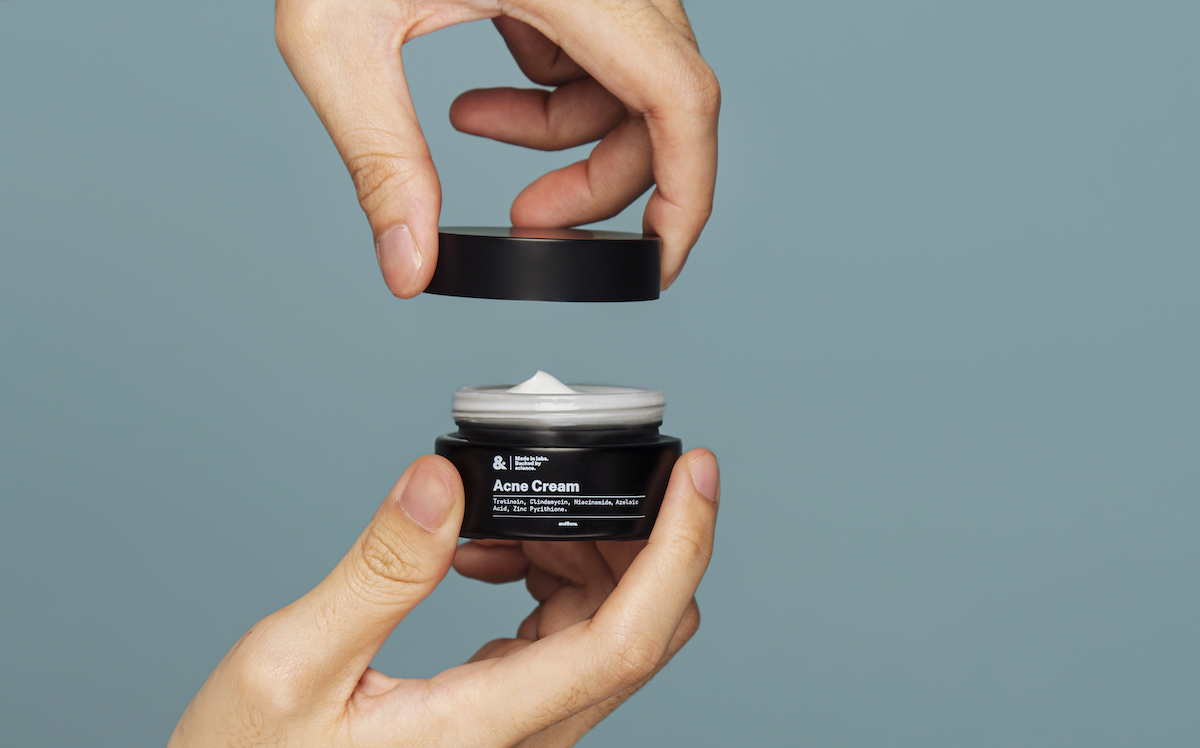Acne refers to a skin condition that occurs when your hair follicles and pores are clogged with bacteria, oil, and dead skin. This build-up can lead to inflamed pores that may appear reddish.
Acne can manifest in the form of whiteheads, blackheads, cysts, pustules, and pimples on your face, chest, shoulders, or back.
More than 90% of the global population is affected by acne at some point throughout their life. Regardless of its prevalence, acne is a treatable disease with medication, creams, and cosmetic technology.
Anatomy of the skin
The skin is the human body’s largest organ and comprises three layers: epidermis, dermis, and hypodermis.
The epidermis is the thin external layer of water-resistant cells that prevent bacteria and germs from entering the body or diffusing into the bloodstream. It also aids in making new skin cells and is responsible for your skin tone.
The dermis is the thicker layer of skin below the epidermis that makes oil (sebum), produces sweat, and is where the roots of hair follicles are attached to. It also has collagen to keep the skin resilient and elastic to ensure its flexibility. It also has connective tissues, blood vessels, and lymphatic vessels.
The final layer is the hypodermis, made of fat deposits, which act as a cushion for the muscles and bones and as a thermal insulator for the body. It contains subcutaneous fat and connective tissues.
According to a Harvard Medical School article, sebum is a complex mixture of fatty acids, sugars, waxes and other natural chemicals that form a protective barrier against water evaporation.
This essentially means that the sebum produces natural oil that coats, protects, and moisturises the skin. However, if sebum is produced in excess quantity, it can get trapped inside the glands, resulting in acne.
Why does acne occur in men?
Men are diagnosed with acne for various reasons, but generally, the most common cause is hormones.
In the case of teenagers, this skin condition sparks due to puberty. During puberty, there is an increase in the androgen hormones, which can cause an overproduction of sebum in the oil glands. This overproduction clogs the pores and allows for acne to form.
However, acne is not a condition that solely affects teenage boys, as hormones like testosterone can also lead to this excess oil production and cause acne in adult men.
What is hormonal acne in men?
Just as the term implies, hormonal acne arises from hormonal imbalance. This imbalance leads to the overproduction of sebum in men, where the skin secretes more oil than what is necessary, so the pores get clogged.
Hormonal acne tends to affect adult men between 20 to 50 years of age, so it is sometimes referred to as adult acne. Symptoms include large red pimples and pus-filled cystic breakouts.
Read: “What is hormonal acne in men?”
Body areas prone to acne
Acne can appear on any part of the body with high sebaceous glands. Some of the most common areas where men get it are:
- Face
- Neck
- Shoulders
- Upper arms
- Chest
- Back

What are the causes of acne in men?
Some of the common causes of acne in men are:
Family history and genetics
It is possible for one parent, both parents, or even prior generations to pass on the inheritance of acne to men. A study from Nature Communications found that 15 genome regions are linked to developing acne. Additionally, another study published in the National Library of Medicine found that hereditary factors are linked to acne.
Stress
When the body is faced with high levels of stress, there is an increase in the production of cortisol and adrenaline hormones. This leads to excessive sweating and oil production, which can clog pores, resulting in acne.
Known as stress acne, this tends to occur on the oiliest parts of the face, like the T-zone. Besides the regular pimple-like breakouts, it can also appear with blackheads, whiteheads, dilated pores, glossy appearances, and uneven or grainy textured skin.
High levels of testosterone
Men can produce a lot of testosterone because of puberty, high blood pressure, infertility, and high libido, among other reasons. The increase of testosterone can lead to the excess production of sebum that combines with dirt and dead skin cells, causing clogged pores, hence acne.
Greasy skin products
With the use of greasy products, the oil levels may be in amounts that are significantly above the natural levels of oil that the body produces. Plus, these products can often be challenging to rinse off with water, soap, or face wash, so they may remain in the body and are not completely removed.
This, combined with the grime, pollutants, and high temperatures, can lead to acne flare-ups.
Steroids
Some men use steroids to support their immune system or stimulate their muscle tissues when engaging in strength training. Using such steroids plays a role in the development of acne since it increases the body’s immune system receptors known as TLR2, which may play a role in an acne breakout.
Steroid acne is a general side effect of prescription corticosteroids, especially prednisone, used in treating certain medical conditions. The symptoms of this form of acne usually disappear when you discontinue the use of steroids.
Medical conditions
Acne can develop as a side-effect of medicines that are prescribed for certain medical conditions. Some of the medicines that can aggravate acne are:
- Antidepressants
- Oral corticosteroids
- Ciclosporin
- Dehydroepiandrosterone (DHEA) supplements
- Azathioprine
- Anticonvulsants
- Androgenic steroids
- B Vitamins
- Barbiturates
Other causes of acne
Apart from the causes mentioned above, men can sometimes get acne from:
- Smoking
- Consuming dietary supplements
- Having a lack of sleep
- Poor hygiene
- Wearing tight-fitting clothes
- Living in humid weather conditions
- Poor diet
Treatment for male acne
Most men can treat their acne in the following ways:
Topical medication
Men affected by acne can apply topical medication like anti-acne creams on areas where the acne is present.
In addition, certain over-the-counter (OTC) medications can help combat acne, like benzoyl peroxide, salicylic acid, tretinoin, and retinoids. These OTC products are meant to be applied topically on areas with acne, and you can purchase them at most pharmacies.
Check out anti-acne cream from andSons Malaysia.
See a doctor or dermatologist
Acne typically goes away as you age, but if you feel that your acne is at a severe stage and you need medical attention, visit a doctor or a dermatologist who can provide you with a more potent prescription medication.
Dermatologists tend to prescribe other topical products and sometimes may even give you medication that you need to consume orally, like antibiotics and tetracycline.
Moreover, dermatologists may suggest laser treatments and chemical peels to reduce the visible acne scars due to the growth of new skin that is generated to replace the old skin.
Antibiotics
Antibiotics can aid in fighting acne by preventing the growth of bacteria or destroying the bacteria. They can also reduce redness and inflammation to a certain extent.
Check for underlying health conditions and get them treated
Certain endocrine and nonendocrine disorders or hormonal disorders can cause acne.
For example, excessive increase in muscle mass, development of testicular or adrenal tumours etc may result in high testosterone, thereby causing acne.
Doctors can help you to evaluate your symptoms and guide you in treating such conditions.
Preventive measures for acne in men
Some of the best ways to prevent the development of acne include:
- Following a disciplined skincare regime.
- Use skincare products suitable to your skin type.
- Wash your face properly to remove excess sweat, dirt and oil.
- Use cold or lukewarm water on your skin.
- Wash your hair regularly to prevent excess oil from seeping onto your face.
- Exfoliate your skin once or twice a week.
- Moisturise your skin in the morning after bath and before going to sleep.
- Apply sunscreen when you step outdoors.
- Stay hydrated by drinking at least 6 to 8 glasses of water every day.
- Avoid acne-enhancing foods such as refined grains, sugar, fast food, chocolate and alcohol, among a few others.
- Limit the use of cosmetics. Use products that are ‘non-comedogenic’ or non-acnegenic (safe for acne-prone skin), ‘hypoallergenic’ (less likely to trigger an allergic reaction) and fragrance-free.
- Do not pop the pimples as it might end up worsening the acne.
When should you see a doctor?
If you do not see any improvements after 7 to 8 weeks of using over-the-counter products, it is advised to visit a doctor.
Doctors and dermatologists can treat acne and recommend the most suitable skincare products for your skin type. They will also consider your age, history of acne, type of acne, genetics, and prior treatments.
Conclusion
Acne can be difficult to deal with and can often affect self-esteem, but it is important to understand that there are many treatments to help combat it.
Speaking to experts about your skin concerns, getting the right treatment, managing acne with preventive care, and using reliable anti-acne products can all play a role in treating acne.
This article is for informational purposes only and does not constitute medical advice. The information contained herein is not a substitute for and should never be relied upon for professional medical advice.
Book a consultation with andSons Malaysia’s medical team to learn more aboutour men’s skincare productsand any skincare concerns.
References
Ballanger, F., Baudry, P., N’Guyen, J. M., Khammari, A., & Dréno, B. (2006). “Heredity: a prognostic factor for acne.” Available at https://pubmed.ncbi.nlm.nih.gov/16484821. [Accessed 16 June 2022]
Cleveland Clinic. (9 Dec. 2021). “When Should Men See a Dermatologist for Adult Acne?” Available at https://health.clevelandclinic.org/when-should-men-see-a-dermatologist-for-adult-acne. [Accessed 16 June 2022]
Gardner, Amanda. (3 Mar. 2021). “What Men Should Know About Acne.” Available at https://www.webmd.com/men/guide/acne-men. [Accessed 16 June 2022]
Harvard Health Publishing. (19 Mar. 2019). “Dry Skin.” Available at https://www.health.harvard.edu/a_to_z/dry-skin-a-to-z. [Accessed 16 June 2022]
Johnson, Jon. (23 Sept. 2021). “Sebaceous hyperplasia: What you need to know.” Available at https://www.medicalnewstoday.com/articles/321550. [Accessed 16 June 2022]
Kam, Katherine. (15 Apr. 2011). “Medications That Can Cause Acne.” Available at https://www.webmd.com/skin-problems-and-treatments/acne/features/medications. [Accessed 16 June 2022]
King’s College London. (12 Dec. 2018). “World’s first acne genetics study gives hope for new treatment.” Available at https://www.kcl.ac.uk/news/world-first-acne-study-uncovers-hope-for-new-treatment. [Accessed 16 June 2022]
Lopez-Ojeda, W., Pandey, A., Alhajj, M., & Oakley A. (22 Oct. 2021). “Anatomy, Skin (Integument).” Available at https://www.ncbi.nlm.nih.gov/books/NBK441980/#:~:text=The%20skin%20is%20primarily%20made,and%20contributes%20to%20skin%20tone. [Accessed 16 June 2022]
Pedroja, Cammy. (26 Nov. 2018). “What Is Sebum and Why Does It Build Up on Skin and Hair?” Available at https://www.healthline.com/health/beauty-skin-care/sebum. [Accessed 16 June 2022]
PR Newswire. (3 Jan. 2018). “Global Acne Market Report for 2016-2026.” Available at https://www.prnewswire.com/news-releases/global-acne-market-report-for-2016-2026-300576931.html. [Accessed 16 June 2022]


